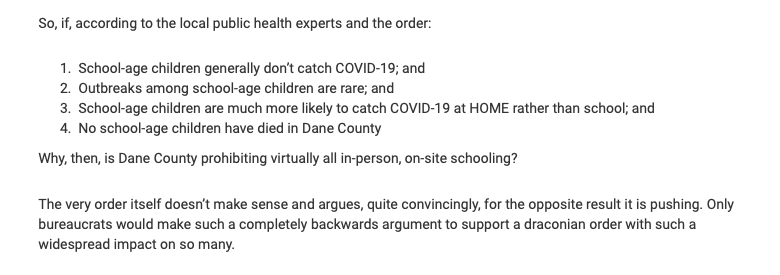
June 11, 2021
In a 4-3 decision, the Wisconsin Supreme Court ruled today that COVID-19 orders issued by Madison and Dane County Public Health Officer Janel Heinrich, which closed schools to in-person instruction, were “unlawful” and “unenforceable.” Writing the majority opinion, Justice Rebecca Bradley ruled that “(1) local health officers do not have the statutory power to close schools under Wis. Stat. § 252.03; and (2) Heinrich’s Order infringes the Petitioners’ fundamental right to the free exercise of religion guaranteed under Article I, Section 18 of the Wisconsin Constitution.” Justices Zeigler, Roggensack, and Hagedorn agreed with the majority opinion, while Justices Dallet, Ann Walsh Bradley, and Karofsky dissented.
Petitioners from three separate parties, including the Wisconsin Council of Religious and Independent Schools (WCRIS), St. Ambrose Academy, and a number of concerned Dane County parents, believed that Heinrich’s orders violated their right to freely exercise their faith, at their religious schools of choice. Petitioners also believed that Heinrich’s orders violated Dane County parents’ rights to make decisions on their kids’ education.
The case was brought before the Court last year after Health Officer Heinrich issued public health orders that closed Dane County K-12 schools to in-person instruction. She first issued an order in May 2020 after the State Supreme Court struck down the Wisconsin Department of Health Services’ Safer at Home order. Heinrich lifted her restrictive orders in the summer of 2020, allowing Dane County K-12 schools to re-open as long as they follow a list of strict reopening guidelines. Many schools, including religious private schools, diligently followed those guidelines, but the Friday before many schools were set to return for their fall semesters, Heinrich issued an order prohibiting kids grades 3-12 from attending in-person instruction.
Justice R. Bradley wrote that state statute expressly allows the state health department to close schools to restrict the spread of disease, but it does not explicitly allow the same for local health officials. Statute allows local health officials to do what is “reasonable and necessary” to curb the spread of a disease, but R. Bradley wrote that “What is reasonable and necessary cannot be reasonably read to encompass anything and everything. Nothing in the text of the statute confers upon local health officers the power to close schools. To conclude otherwise would be tantamount to striking language from the statute.”
R. Bradley further asserted that Heinrich’s decision, by her own admission, was unnecessary to curb the spread of COVID-19. ‘The Order acknowledged that a “number of systematic reviews have found that school-aged children contract COVID at lower rates than older populations” and that “[o]utbreaks and clusters among cases aged 5-17 have been rare.’ ”

“The Order failed to explain why college-aged students could continue to live, learn, and socialize in close communities, while students in grades 3-12 were consigned to computer screens,” R. Bradley wrote. “While the Order demonstrates the availability of less restrictive alternatives and employs them for college students as well as students in grades K-2, the Order denies them to students in grades 3-12.”
On the religious freedoms question, Justice Bradely wrote that “Heinrich’s Order not only impeded the Petitioners’ religious expression and practice, it outright precluded both from occurring in Petitioners’ schools altogether.”
R. Bradley wrote, “While Heinrich allowed schools to use their premises for child care and youth recreational activities, the government barred students from attending Mass, receiving Holy Communion at weekly Masses with their classmates and teachers, receiving the sacrament of Confession at school, participating in communal prayer with their peers, and going on retreats and service missions throughout the area.”
Justices Rebecca Dallet and Brian Hagedorn criticized R. Bradley for applying a constitutional analysis to this case. Hagedorn specifically wrote that, “We are not charged by the constitution to provide clarity whenever a constitutional question is unresolved. We are not empowered to ensure all constitutional violations are corrected.”
R. Bradley asserted that, “Our duty to uphold the Constitution, however, is particularly urgent when governmental action is alleged to infringe the people’s fundamental right to religious freedom… Declining to decide the constitutional question in this case would “shirk[] our duty” to say what the supreme law of our state is.”
“As the bulwark of our Wisconsin Constitution, we should defend the people’s rights with fortitude, not modesty,” R. Bradley wrote.